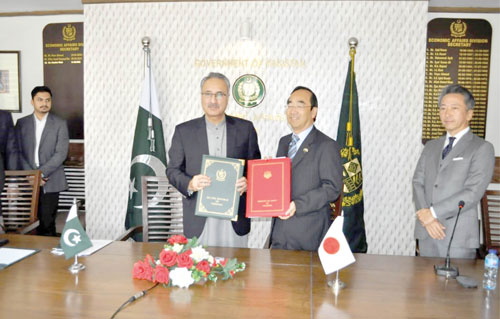Zubair Qureshi Islamabad
The Japan government has agreed to provide new grant assistance worth 1,686 million Japanese Yen (equivalent to around US$ 12.7 million around PKR 3,510 million) for upgrading primary girls schools into elementary schools in rural Sindh.
In this regard, a signing ceremony for the assistance was held at the Ministry of Economic Affairs on Friday.
Wada Mitsuhiro, Ambassador of Japan, Kinoshita Yasumitsu, Chief Representative of Japan International Cooperation Agency (JICA), Dr. Kazim Niaz, Secretary, Ministry of Economic Affairs, and other officials from both countries attended this ceremony.
The project has been conceived keeping in view the facts that the number of middle/elementary schools is much lower (2,162) than the primary schools (35,377) in rural Sindh. This particular issue is also adversely affecting the primary school student’s retention & the biggest cause of student’s dropout from school. The net enrollment rate for lower-secondary education (grades 6-8) is 49pc (boys 53pc, girls 45pc).
Girls in the government schools drop out drastically from primary education as the middle or high schools are not available in close vicinity, particularly in rural Sindh. According to Alif Alan, the accessibility distance hinders girls’ education more (13pc dropout due to access) than boys (5pc dropout due to access).
This project aims to improve access of girls’ middle education by providing school facilities for female students in rural areas of Sindh Province. This is the third grant aid through which Japan will be upgrading 20 new primary girl’s schools into elementary schools, which brings the total number of schools provided with Japan’s assistance to 74. The assistance contributes to improve the school enrollment rate and gender equality in the target areas, contributing to the SDGs Goal 4 (Quality education) and 5 (Gender equality).
In the signing ceremony, Wada Mitsuhiro stated, “This project will also be implemented in the areas affected by the devastating flood last year. I sincerely hope that this project will contribute to the reconstruction efforts of Pakistani people. And, it is my hope that girls educated in these schools will play an active role in various fields in Pakistan.”
Kinoshita, while speaking at the event said, “As some of the target districts of the project were affected by the flood last year, we hope that the new grant aid project will bring the hope back to the brave & resilient girls’ students and keep them motivated so that they remain on track for “learning continuity”, during the post floods recovery phase.”










